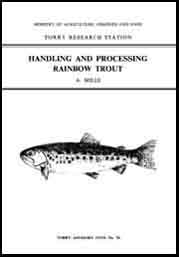Contents Index

Accompanying Notes
Table of Contents
A. MILLS
MINISTRY OF AGRICULTURE, FISHERIES AND FOOD
TORRY RESEARCH STATION
TORRY ADVISORY NOTE No. 74
Crown copyright material is reproduced with the permission of the Controller of Her Majesty's Stationery Office.
This electronic document has been scanned using optical character recognition (OCR) software and careful manual recorrection. Even if the quality of digitalisation is high, the FAO declines all responsibility for any discrepancies that may exist between the present document and its original printed version.
Provides background and general information with illustrations and tables on rainbow trout, including, common, scientific and foreign names, distinguishing features, distribution, length and weight, and chemical composition. Advises on handling fresh trout, chilling, freezing, brining and hot smoking, yield, packing, and on the storage life of chilled and frozen hot smoked fish. Emphasises that since hot smoked trout is ready for eating without further cooking, it is important that the salt concentration in the product and the temperature of distribution is such that food poisoning bacteria such as Clostridium botulinum cannot grow. It makes the important distinction between the salt content and the salt concentration in the water phase of the product. More recent advice recommends a minimum salt concentration of 3.5% (weight by weight) in the water phase and keeping the product chilled below 5°C throughout the distribution chain. Particular attention should be given to the control of the botulinum risk if the product is to be vacuum packed ,because C. botulinum can grow in the absence of oxygen (anaerobic conditions), and because of the inhibition of competing spoilage organisms (also see the accompanying notes to Advisory Note 22).
Gaping is not a problem in trout that are sold whole, but an increasing amount of large trout are now sold as fillets and gaping can be a problem and relevant information on this topic is provided in Note 90.
(FAO in partnership with Support unit for International Fisheries and Aquatic Research, SIFAR, 2001).
Introduction
Scientific names
Common names
Distinguishing features
Distribution
Size and weight
Chemical composition
Handling fresh trout
Frozen trout
Smoked trout
Contents Index